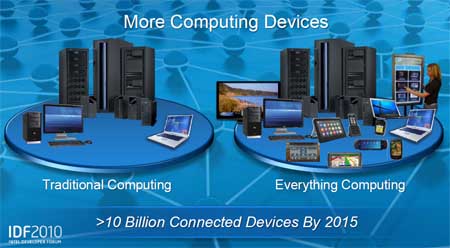Intel, AMD hunt for growth beyond the PC

Despite lots of talk about things slowing down, the PC market has held up surprisingly well. Last year, in the midst of a recession, PC unit sales actually increased--thanks to the continued strength of laptops. Despite this it is increasingly clear that chipmakers see the real opportunities for growth in areas outside the PC.
Intel's Atom has been a commercial success--thanks to the netbook phenomenon--and the company has created numerous versions for embedded markets (most recently the "Tunnel Creek" SoC for IP phones, printers and cars, unveiled last week at the Intel Developer Forum in Beijing). But it hasn't made much progress on smartphones, and Mobile Internet Devices (MIDs) have gone nowhere.
Now Intel is looking for ways to speed up its mobile efforts. Citing the recent Wind River acquisition, CFO Stacy Smith told Bloomberg this week that Intel planned to use its $16 billion war-chest to "accelerate. . .progress in those markets." Meanwhile an Intel software evangelist told UK-based TechRadar that the company developed its own Linux-based operating system for mobile devices because Microsoft wasn't moving fast enough with Windows.
Microsoft hasn't been quite as aggressive as we might have hoped at supporting Atom, especially in the embedded space and that's why we came up with our platform Moblin - which is now MeeGo. Intel is all about platform choice, choice of operating system and so on, and we believe in the opportunity of embedded very strongly.
Some of their Windows offerings are great now, but Moblin started a number of years ago when we didn't see Windows in that space at all. We're thrilled to death to see user mode scheduling in Windows 7 but the progress of Windows 7 still limited - it doesn't go all the places we think Atom will go.
AMD has some holes to fill in its laptop lineup. In its recent quarterly earnings call, CEO Dirk Meyer conceded that AMD was still "under-represented" in notebooks. But that hasn't stopped AMD from looking at other mobile markets as well. The same Bobcat microarchitecture that will be used in its Fusion CPU+GPU chips for netbooks and laptops--due out next year--will also be used devices such as tablets, Meyer added. AMD is moving into this space after it was forced to sell-off some of these non-PC divisions, including handheld products now used in Qualcomm's Snapdragon processor, a director competitor.
Both Intel and AMD are running smack into lots of new competition as they move beyond the PC. Qualcomm is just one of several companies combining 1GHz-plus multi-core Arm Cortex processors with high-performance GPUs to address this market for high-end smartphones, tablets and related devices. The Apple iPad illustrates just how well this combination can work on devices that are larger than smartphones.
Samsung, which already manufactures chips for the iPhone and most likely the iPad, is rumored to be working on more powerful dual- and quad-core processors with Arm Cortex cores and Mali GPUs for netbooks and other devices running Google's Chrome OS or Ubuntu Linux. Marvell announced at the Consumer Electronics Show earlier this year that it had developed a quad-core ARM-based chip. And Nvidia is putting the finishing touches on its Tegra 2 SoC, which could soon show up in devices such as Toshiba tablets and Windows 7 smartphones. Finally, Google, seems to be on target to deliver Chrome OS later this year, just acquired a chip start-up, Agnilux, which should help it integrate the Web-based OS not only in netbooks, but also in tablets and embedded devices, according to The New York Times.
